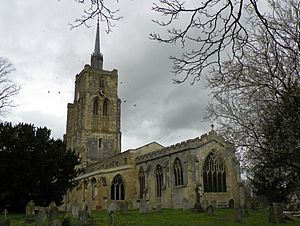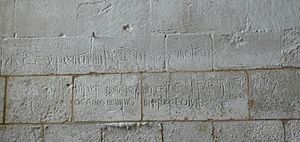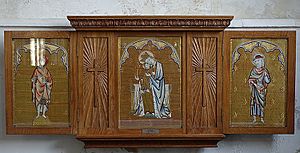Church of St Mary the Virgin, Ashwell facts for kids
The Church of St Mary the Virgin in Ashwell, Hertfordshire, is a very old and important Anglican church for the village. It's one of the biggest village churches in the area! Most of the church was built in the 1300s. It's famous for its tall tower, which stands at 176 feet (54 m) (about 54 meters) and has a cool, pointed top. Inside, you can find some old graffiti carved into the walls. This graffiti tells a sad story about people who survived the terrible sickness called the Black Death. The church is so special that it's been a Grade I listed building since 1968.
Discovering St Mary's Church
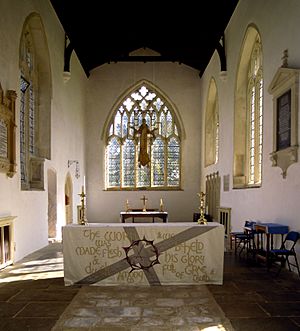

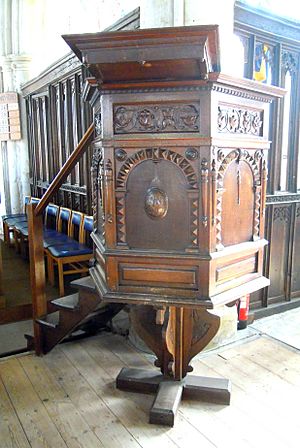
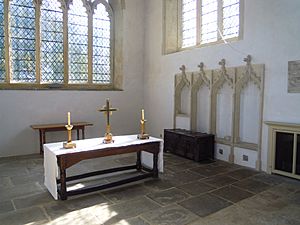
We don't know if an older church was here before. But if there was, its materials might have been used to build the church we see today. The current church was finished in 1381. It was built using clunch (a type of limestone), flint, and some red bricks.
St Mary's church is a really impressive building. It has a large tower on the west side. This tower was built in four parts. The top half was added after 1415. The lead-covered wooden spire was put on between 1415 and 1562. At 176 feet (54 m) (54 meters) tall, including the spire, the tower is the tallest in all of Hertfordshire!
The North porch and the windows in the aisles were added in the 1400s. The North porch still has its original door arch and windows. The South porch is older, from the 1300s. It also has many original features. The nave (the main part of the church) has five sections. The chancel (the area around the altar) still has its seats for priests from the mid-1300s.
The original screen that separated the chancel from the nave was probably removed. This happened during the English Reformation. Today, there is a modern cross above the altar. It shows The Risen Christ. This cross was made by John Mills. He is a famous sculptor who lives nearby.
The old stained glass in the East window was very special. It showed scenes from the life of Thomas Becket. But in 1538, Henry VIII ordered it to be removed. You can still find three small pieces of this old glass. They are in the windows of the North Aisle. Other tiny pieces were found in the churchyard. They have been placed in modern clear glass.
The wooden pulpit (where sermons are given) is shaped like a hexagon. It was made in 1627. The church also has a beautiful wooden screen from the 1400s. It leads to the Lady Chapel. The baptismal font (used for baptisms) is a copy from the 1800s. But it stands on an older base from the 1400s. There are also benches from the 1400s near the chancel.
In 1956, a famous poet named Sir John Betjeman visited Ashwell. He wrote about St Mary's church:
"So I went to Ashwell which is near nowhere... We first saw its gigantic dark grey fourteenth-century church tower... And the church inside, white and spacious and East Anglian, with arcades like a Cathedral, clear glass everywhere, uneven floors and splendid chancel, was worthy of the best of English villages."
Today, St Mary's is a popular place for music concerts and festivals.
Ashwell's Ancient Graffiti
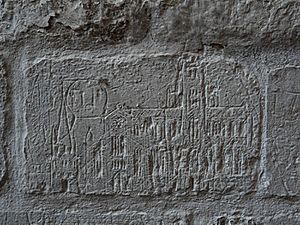
On the North wall of the West tower, you can find some amazing graffiti from the 1300s. One carving is a message about people surviving the terrible sickness called the Black Death. There's also an early drawing of Old St Paul's Cathedral in London. We don't know who carved the graffiti or exactly when.
One carving on the church tower says:
"MCT Expente miseranda ferox, violenta Superest plebs pessima testis, MCCCL"
This means:
"1350 Miserable, wild, distracted 1350
The dregs of the mob alone survive to witness"
This message is about the bubonic plague (Black Death). It happened during the time of King Edward III. Ashwell suffered a lot during this period.
Another carving from 1361 says:
"In finque ventus validus oc anne maurus orbe tonat MCCCLXI"
Which means:
"And in the end a tempest full and mighty
This year 1361 thunders mightily in the world"
This line probably talks about a very strong storm. It happened on St Maur's Day, January 15, 1361. Some people think this storm might have helped clear away the last traces of the Black Death.
Below this, on the same wall, is a drawing. People think it's a sketch of Old St Paul's Cathedral. This cathedral later burned down in the Great Fire of London in 1666. This drawing is very important. It's rare to find such detailed drawings of buildings from the Middle Ages. The drawing was made sometime in the 1300s or 1400s. It shows a building in the Perpendicular style. If it is St Paul's, it must have been made before 1561. That's when St Paul's spire fell down.
Most of the other graffiti in the church is scratched on the pillars in the nave. On one pillar, there's a message that hasn't been fully understood yet. It might be about the church being officially opened. On another pillar, near the south door, there's a funny comment from a frustrated architect: "Cornua non sunt arto compugente-sputo" – meaning "The corners are not pointed correctly – I spit". On another pillar, someone wrote about being unhappy in love: "Barbara filia barbara est" – "Barbara is the daughter of a barbarian".
Bells and Beautiful Embroideries
The church has six bells hanging in its tower. The frame holding them is from the 1400s. The second bell is the oldest, made in 1694. The fifth bell was made in 1808. The other bells were made between 1787 and 1817.
Around the church, you can see amazing embroideries. One very special one is the reredos (a decorated screen) behind the altar in the Lady Chapel. It shows The Virgin and Child with St James and St John the Baptist. These were all made by Percy Sheldrick (1890–1979) from Ashwell. He was a master weaver and embroiderer. He worked at William Morris' workshops in the 1920s.
One of his biggest works was 'The Passing of Venus'. It was based on a design by the Pre-Raphaelite Brotherhood artist Edward Burne-Jones. This piece has 18 life-sized figures! It is now in Lansing Community College in Michigan. Percy Sheldrick left the workshops in 1939. He came back to Ashwell and worked for an antique dealer. He also helped out at St Mary's as a Verger. He kept embroidering in his free time. His beautiful work can be found in collections all over the world.


